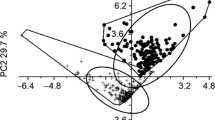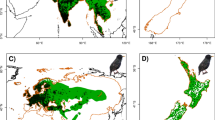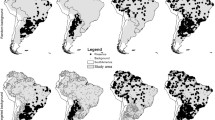Abstract
Human transport and commerce have led to an increased spread of non-indigenous species. Alien invasive species can have major impacts on many aspects of ecological systems. Therefore, the ability to predict regions potentially suitable for alien species, which are hence at high risk, has become a core task for successful management. The Common Waxbill Estrilda astrild is a widespread African species, which has been successfully introduced to many parts of the world. Herein, we used MAXENT software, a machine-learning algorithm, to assess its current potential distribution based on species records compiled from various sources. Models were trained separately with records from the species’ native range and from both invaded and native ranges. Subsequently, the models were projected onto different future climate change scenarios. They successfully identified the species known range as well as some regions that seem climatically well suited, where the Common Waxbill is not yet recorded. Assuming future conditions, the models suggest poleward range shifts. However, its potential distribution pattern within its tropical native and invasive ranges appears to be more complex. Although the results of both separate analyses showed general similarities, many differences have become obvious. Niche overlap analysis shows that the invasive range includes only a small fraction of the ecological space that can be found in the native range. Thus, we tentatively prefer the model based on native locations only, but in particular, we highlight the importance of the selection process of species records for modelling invasive species.
Zusammenfassung
Weltweiter Handel und Mobilität haben zu einer zunehmenden Ausbreitung nicht-heimischer Arten geführt. Invasive Arten können großen Einfluss auf zahlreiche Aspekte ökosystemarer Zusammenhänge haben. Deshalb ist die Fähigkeit, Regionen vorherzusagen, die für solche Arten potentiell geeignet und daher möglicherweise bedroht sind, eine Kernaufgabe erfolgreichen Managements. Der Wellenastrild Estrilda astrild ist eine weit verbreitete afrikanische Art, die erfolgreich in viele Gebiete der Welt eingeführt wurde. Mit Hilfe der Software MAXENT, einem Algorithmus, der auf maschinellem Lernen basiert, haben wir seine gegenwärtige, potentielle Verbreitung basierend auf Fundpunkten aus verschiedenen Quellen modelliert. Die Modelle wurden sowohl mit Nachweisen aus dem heimischen als auch dem invasiven und heimischen Verbreitungsgebiet gemeinsam trainiert. Nachfolgend wurden beide auf unterschiedliche zukünftige Klimawandelszenarien projiziert. Die Modelle identifizierten erfolgreich sowohl das bekannte Verbreitungsgebiet der Art, als auch Gebiete, die klimatisch gut geeignet erscheinen, in denen der Wellenastrild aber noch nicht nachgewiesen wurde. Unter zukünftigen Bedingungen legen die Modelle eine polwärts gerichtete Verschiebung der Verbreitungsgebiete nahe, obwohl die Muster der potentiellen Verbreitung innerhalb der Tropen des heimischen und invasiven Areals komplexer erscheinen. Trotz allgemeiner Übereinstimmung zwischen beiden Analysen wurden einige Unterschiede auffällig. Eine Analyse des Überlappungsbereiches der Nischen ergab, dass invasive Fundpunkte innerhalb des ökologischen Raumes liegen, der durch die Fundpunkte aus dem natürlichen Verbreitungsgebiet aufgespannt wird. Wir tendieren daher vorsichtig zu dem Modell basierend auf der natürlichen Verbreitung, unterstreichen aber vor allem die Bedeutung des Auswahlprozesses der Fundorte für Modellierungen invasiver Arten.







Similar content being viewed by others
References
Araujo MB, Pearson RG (2005) Equilibrium of species’ distributions with climate. Ecography 28:693–695
Austin MP (2002) Spatial prediction of species distribution: an interface between ecological theory and statistical modelling. Ecol Model 157:101–118
Baldwin RA (2009) Use of maximum entropy modelling in wildlife research. Entropy 11:854–866
Beale CM, Lennon JJ, Gimona A (2008) Opening the climate envelope reveals no macroscale associations with climate in European birds. Proc Natl Acad Sci USA 105:14908–14912
Beaumont LJ, Hughes L, Poulsen M (2005) Predicting species distributions: use of climatic parameters in BIOCLIM and its impact on predictions of species’ current and future distributions. Ecol Model 186:250–269
Beaumont LJ, Gallagher RV, Thuiller W, Downey PO, Leishman MR, Hughes L (2009) Different climatic envelopes among invasive populations may lead to underestimations of current and future biological invasions. Divers Distrib 15:409–420
Blackburn TM, Lockwood JL, Cassey P (2009) Avian invasions. The ecology and evolution of exotic birds. Oxford avian biology series, vol 1. Oxford University Press, Oxford
Broennimann O, Guisan A (2008) Predicting current and future biological invasions: both native and invaded ranges matter. Biol Lett 4:585–589
Broennimann O, Treier UA, Müller-Schärer H, Thuiller W, Peterson AT, Guisan A (2007) Evidence of climatic niche shift during biological invasion. Ecol Lett 10:701–709
Busby JR (1991) BIOCLIM–A bioclimatic analysis and predictive system. In: Margules CR, Austin MP (eds) Nature conservation: cost effective biological surveys and data analysis. CSIRO, Canberra, pp 64–68
Clement P, Harris A, Davis J (1993) Finches and sparrows. An identification guide. Black, London
Cueto VR, Marone L, Lopez de Casenave L (2006) Seed preferences in sparrow species of the monte desert, Argentina: implications for seed-granivore interactions. Auk 123:358–367
Davis AJ, Jenkinson LS, Lawton JH, Shorrocks B, Wood S (1998) Making mistakes when predicting shifts in species range in response to global warming. Nature 391:783–786
Dickinson EC (2003) The Howard and moore complete checklist of the birds of the world, 3rd edn. Princeton University Press, Princeton
Dormann CF, McPherson JM, Araújo MB, Bivand R, Bolliger J, Carl G, Davies RG, Hirzel A, Jetz W, Kissling WD, Kühn I, Ohlemüller R, Peres-Neto PR, Reineking B, Schröder B, Schurr FM, Wilson R (2007) Methods to account for spatial autocorrelation in the analysis of species distributional data: a review. Ecography 30:609–628
Echarri F, Tambussi C, Hospitaleche CA (2009) Predicting the distribution of the crested tinamous, Eudromia spp. (Aves, Tinamiformes). J Ornithol 150:75–84
Elith J, Leathwick JR (2009) Species distribution models: ecological explanation and prediction across space and time. Annu Rev Ecol Evol Syst 40:677–697
Elith J, Graham CH, Anderson RP, Dudik M, Ferrier S, Guisan A, Hijmans RJ, Huettmann F, Leathwick JR, Li J, Lohmann LG, Loiselle BA, Manion G, Moritz C, Nakamura M, Nakazawa Y, Overton JMM, Peterson AT, Phillips SJ, Richardson K, Scachetti-Pereira R, Schapire RE, Soberón J, Williams S, Wisz MS, Zimmermann NE (2006) Novel methods improve prediction of species’ distributions form occurrence data. Ecography 29:129–151
Elith J, Kearney M, Phillips S (2010) The art of modelling range-shifting species. Methods Ecol Evol 1:330–342
Fitzpatrick MC, Weltzin JF, Sanders NJ, Dunn RR (2007) The biogeography of prediction error: why does the introduced range of the fire ant over-predict its native range? Glob Ecol Biogeogr 16:24–33
Fry CH (2004) Estrilda astrild. In: Fry CH, Keith S (eds) The birds of Africa, vol VII. Christopher Helm, London
Gallien L, Münkemüller T, Albert CH, Boulangeat I, Thuiller W (2010) Predicting potential distributions of invasive species: where to go from here? Divers Distrib. doi:https://doi.org/10.1111/j.1472-4642.2010.00652.x
Gatter W (1998) Birds of Liberia. Pica, Mountfield
Gioia P, Pigott P (2000) Biodiversity assessment: a case study in predicting richness from the potential distribution of plant species in the forests of south-western Australia. J Biogeogr 27:1065–1078
Goodwin D (1982) Estrildid finches of the world. British Museum (Natural History), London
Graham CH, Elith J, Hijmans RJ, Guisan A, Peterson TA, Loiselle BA, The NCEAS Predicting Species Distributions Working Group (2008) The influence of spatial errors in species occurrence data used in distribution models. J Appl Ecol 45:239–247
Guisan A, Thuiller W (2005) Predicting species distribution: offering more than simple habitat models. Ecol Lett 8:993–1009
Heikkinen RK, Luoto M, Araújo MB, Virkkala R, Thullier W, Sykes MT (2006) Methods and uncertainties in bioclimatic envelope modelling under climate change. Prog Phys Geogr 30:751–777
Hernandez PA, Graham CH, Master LL, Albert DL (2006) The effect of sample size and species characteristics on performance of different species distribution modelling methods. Ecography 29:773–785
Hijmans RJ, Cruz JM, Rojas E, Guarino L (2001) DIVA-GIS, version 1.4. A geographic information system for the management and analysis of genetic resources data. Manual. International Potato Center and International Plant Genetic Resources Institute, Lima, Peru
Hijmans RJ, Cameron SE, Parra JL, Jones PG, Jarvis A (2005) Very high resolution interpolated climate surfaces for global land areas. Int J Clim 25:1965–1978
Hutchinson GE (1957) Concluding remarks. Cold Spring Harb Symp Quant Biol 22:415–427
Jeschke JM, Strayer DL (2008) Usefulness of bioclimatic models for studying climate change and invasive species. Ann NY Acad Sci 1134:1–24
Leonard P (2005) Important bird areas in Zambia. The Zambian Ornithological Society, Lusaka
Lever C (2005) Naturalised birds of the world. Poyser, London
Liu C, Berry PM, Dawson TP, Pearson RG (2005) Selecting thresholds of occurrence in the prediction of species distributions. Ecography 28:385–393
Lobo JM, Jiménez-Valverde A, Real R (2008) AUC: a misleading measure of the performance of predictive distribution models. Glob Ecol Biogeogr 17:145–151
Lockwood JL, Moulton MP (1994) Ecomorphological pattern in Bermuda birds: the influence of competition and implications for nature preserves. Evol Ecol 8:53–60
Losos JB (2008) Phylogenetic niche conservatisms, phylogenetic signal and the relationship bewteen phylogenetic relatedness and ecological similarity among species. Ecol Lett 11:995–1007
Mack RN, Simberloff D, Lonsdale WM, Evans H, Clout M, Bazzaz FA (2000) Biotic invasions: causes, epidemiology, global consequences, and control. Ecol Appl 10:689–710
Manhães MA, Loures-Ribeiro A (2005) Spatial distribution and diversity of bird community in an urban area of Southeast Brazil. Braz Arch Biol Techn 48:285–294
Martinez-Meyer E, Peterson AT, Navarro-Sigüenza AG (2004) Evolution of seasonal ecological niches in the Passerina buntings (Aves: Cardinalidae). Proc R Soc Lond B 271:1151–1157
Mau KG (2002) Weltbürger Wellenastrild. Gefiederte Welt 126:258–261
Mau-Crimmins TM, Schussman HR, Geiger EL (2006) Can the invaded range of a species be predicted using only native-range data? Lehmann lovegrass (Eragrostis lehmanniana) in the southwestern United States. Ecol Model 193:736–746
Menke SB, Holway DA, Fisher RN, Jetz W (2009) Characterizing and predicting species distributions across environments and scales: argentine ant occurrences in the eye of the beholder. Glob Ecol Biogeogr 18:50–63
Mooney HA, Cleland EE (2001) The evolutionary impact of invasive species. Proc Natl Acad Sci USA 98:5446–5451
Nicolai J, Steinbacher J (eds) (2007) Handbuch der Vogelpflege. Prachtfinken. Afrika, 3rd edn. Eugen Ulmer, Stuttgart
Parmesan C (2006) Ecological and evolutionary responses to recent climate change. Annu Rev Ecol Evol Syst 37:637–669
Pearson RG, Dawson TE (2003) Predicting the impacts of climate change on the distribution of species: are bioclimate envelope models useful? Glob Ecol Biogeogr 12:361–371
Peterson TA (2001) Predicting species’ geographic distributions based on ecological niche modeling. Condor 103:599–605
Peterson AT, Nyári ÁS (2007) Ecological niche conservatism and pleistocene refugia in the thrush-like murner, Schiffornis sp., in the Neotropics. Evolution 62:173–183
Peterson AT, Robins CR (2003) Using ecological-niche modeling to predict barred owl invasions with implications for spotted owl conservation. Conserv Biol 17:1161–1165
Peterson AT, Vieglais DA (2001) Predicting species invasions using ecological niche modeling: new approaches from bioinformatics attack a pressing problem. Bioscience 51:363–371
Peterson AT, Soberon J, Sanchez-Cordero V (1999) Conservatism of ecological niches in evolutionary time. Science 285:1265–1267
Peterson AT, Ortega-Huerta MA, Bartley J, Sanchez-Cordero V, Soberon J, Buddemeier RH, Stockwell DRB (2002) Future projections for Mexican faunas under global climate change scenarios. Nature 416:626–629
Phillips SJ, Dudík M, Schapire RE (2004) A maximum entropy approach to species distribution modeling. Proceedings of the 21st international conference on machine learning. Banff, Canada
Phillips SJ, Anderson RP, Schapire RE (2006) Maximum entropy modeling of species geographic distributions. Ecol Model 190:231–259
Phillips SJ, Dudík M, Elith J, Graham CH, Lehmann A, Leathwick J, Ferrier S (2009) Sample selection bias and presence-only distribution models: implications for background and pseudoabsence data. Ecol Appl 19:181–197
Reino L (2005) Variation partitioning for range expansion of an introduced species: the common waxbill Estrilda astrild in Portugal. J Ornithol 146:377–382
Reino L, Silva T (1998) The distribution and expansion of the Common Waxbill (Estrilda astrild) in the Iberian Peninsula. Biol Cons Fauna 102:163–167
Reino L, Moya-Laraño J, Heitor AC (2009) Using survival regression to study patterns of expansion of invasive species: will the common waxbill expand with global warming? Ecography 32:237–247
Restall R (1996) Munias and mannikins. Pica, Mountfield
Ricklefs RE (1974) Energetics of reproduction in birds. In: Paynter R (ed) Avian energetics. Publ Nuttall Ornithol Club 15:152–297
Ridgely RS, Tudor G (2009) Field guide to the songbirds of South America: the passerines (Mildred Wyatt-Wold series in ornithology). Texas University Press, Austin
Rödder D, Dambach J (2010) Bioclimatic models as predictive GIS tools for the identification of potential refuges and possible migration pathways. In: Habel JC, Assmann T (eds) Relict species: phylogeography and conservation biology. Springer, Berlin
Rödder D, Engler JO (2011) Quantitative metrics of overlaps in Grinnellian niches: advances and possible drawbacks. Glob Ecol Biogeogr (in press)
Rödder D, Lötters S (2009) Niche shift versus niche conservatism? Climatic characteristics of the native and invasive ranges of the Mediterranean house gecko (Hemidactylus turcicus). Glob Ecol Biogeogr 18:674–687
Rödder D, Lötters S (2010) Potential distribution of the alien invasive brown tree snake, Boiga irregularis (Reptilia: Colubridae). Pac Sci 64:11–22
Rödder D, Solé M, Böhme W (2008a) Predicting the potential distribution of two alien invasive Housegeckos (Gekkonidae: Hemidactylus frenatus, Hemidactylus mabouia). North-West J Zool 4:236–246
Rödder D, Veith M, Lötters S (2008b) Environmental gradients explaining prevalence and intensity of infection with the amphibian chytrid fungus: the host’s perspective. Anim Conserv 11:513–517
Rödder D, Kielgast J, Bielby J, Schmdtlein S, Bosch J, Garner TWJ, Veith M, Walker S, Fisher MC, Lötters S (2009a) Global amphibian extinctions risk assessment for the panzootic chytrid fungus. Diversity 1:52–66
Rödder D, Schmidtlein S, Veith M, Lotters S (2009b) Alien invasive slider turtle in unpredicted habitat: a matter of niche shift or of predictors studied? PLoS ONE 4:e7843
Schluter D, Repasky RR (1991) Worldwide limitation of finch densities by food and other factors. Ecology 72:1763–1774
Silva JMC (1999) Seasonal movements and conservation of seedeaters of the genus Sporophila in South America. Stud Avian Biol 19:272–280
Silva T, Reino L, Borralho R (2002) A model for range expansion of an introduced species: the common waxbill Estrilda astrild in Portugal. Divers Distrib 8:319–326
Soberón J (2007) Grinnellian and Eltonian niches and geographic distributions of species. Ecol Lett 10:1115–1123
Soberón J, Peterson AT (2005) Interpretation of models of fundamental ecological niches and species’ distributional areas. Biodivers Inform 2:1–10
Steinbacher J, Wolters HE (eds) (1965) Vögel in Käfig und Voliere. Ein Handbuch für Vogelliebhaber. Prachtfinken, vol 1: Astrilde, 2nd edn. Hans Limberg, Aachen
Strubbe D, Matthysen E (2009) Establishment success of invasive ring-necked and monk parakeets in Europe. J Biogeogr 36:2264–2278
Swets K (1988) Measuring the accuracy of diagnostic systems. Science 240:1285–1293
Thomas CC, Lennon JJ (1999) Birds extend their ranges northward. Nature 399:213
Thuiller W, Richardson DM, Pyšek P, Midgley GF, Hughes GO, Rouget M (2005) Niche-based modelling as a tool for predicting the risk of alien plant invasions at a global scale. Glob Change Biol 11:2234–2250
Waltari E, Hijmans RJ, Peterson AT, Nyári AS, Perkins SL, Guralnick RP (2007) Locating pleistocene refugia: comparing phylogeographic and ecological niche model predictions. PLoS ONE 2(7) e563. doi:https://doi.org/10.1371/journal.pone.0000563
Walther BA, Wisz MS, Rahbek C (2004) Known and predicted African Winter distributions and habitat use of the endangered Basra reed warbler (Acrocephalus griseldis) and the near-threatened cinereous bunting (Emberiza cineracea). J Ornithol 145:287–299
Warren DL, Glor RE, Turelli REM (2008) Environmental niche equivalency versus conservatism: quantitative approaches to niche evolution. Evolution 62:2868–2883
Wiens JJ, Graham CH (2005) Niche conservatism: integrating evolution, ecology and conservation biology. Annu Rev Ecol Evol Syst 36:519–539
Wisz MS, Hijmans RJ, Peterson AT, Graham CH, Guisan A, Group NPSDW (2008) Effects of sample size on the performance of species distribution models. Divers Distrib 14:763–773
Yost AC, Petersen SL, Gregg M, Miller R (2008) Predictive modeling and mapping sage grouse (Centrocercus urophasianus) nesting habitat using Maximum Entropy and a long-term dataset from Southern Oregon. Ecol Inform 3:375–386
Acknowledgments
We thank two anonymous referees for their comments on the manuscript. D.R. is grateful to the research initiative of the Ministry of Education, Science, Youth and Culture of the Rhineland-Palatinate state of Germany for financial support.
Author information
Authors and Affiliations
Corresponding author
Additional information
Communicated by T. Friedl.
An erratum to this article can be found at http://dx.doi.org/10.1007/s10336-011-0728-8
Electronic supplementary material
Below is the link to the electronic supplementary material.
Rights and permissions
About this article
Cite this article
Stiels, D., Schidelko, K., Engler, J.O. et al. Predicting the potential distribution of the invasive Common Waxbill Estrilda astrild (Passeriformes: Estrildidae). J Ornithol 152, 769–780 (2011). https://doi.org/10.1007/s10336-011-0662-9
Received:
Revised:
Accepted:
Published:
Issue Date:
DOI: https://doi.org/10.1007/s10336-011-0662-9




